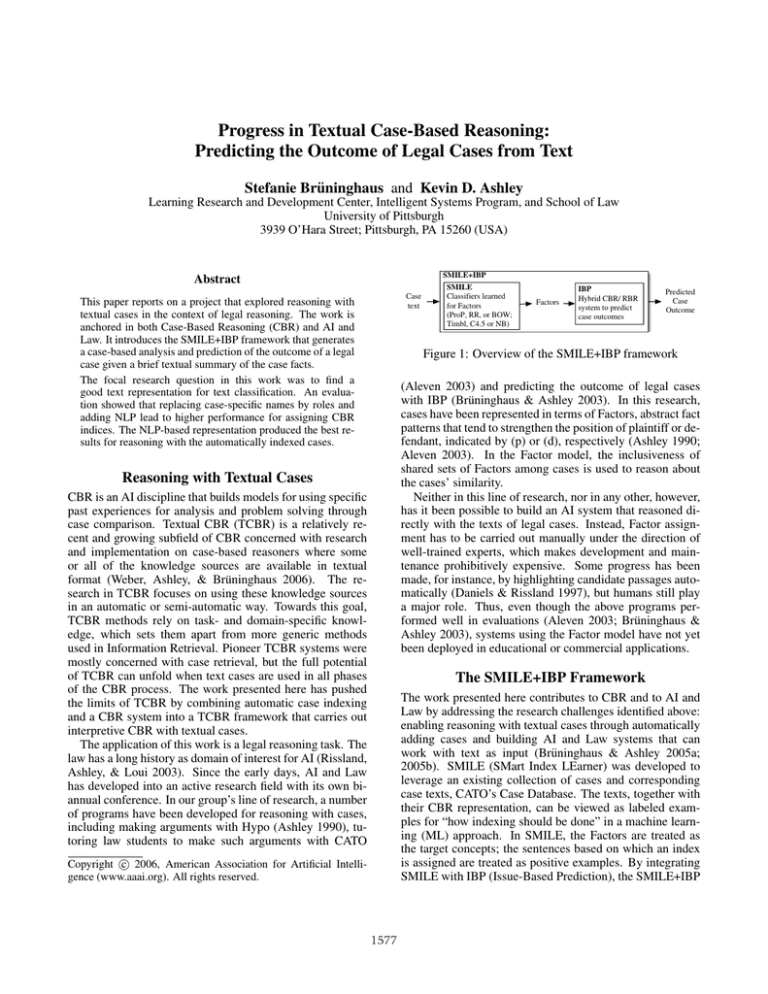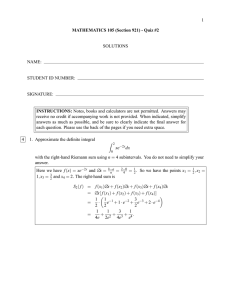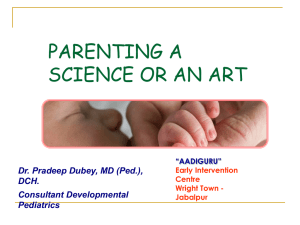Progress in Textual Case-Based Reasoning: Stefanie Br¨uninghaus and Kevin D. Ashley
advertisement

Progress in Textual Case-Based Reasoning: Predicting the Outcome of Legal Cases from Text Stefanie Brüninghaus and Kevin D. Ashley Learning Research and Development Center, Intelligent Systems Program, and School of Law University of Pittsburgh 3939 O’Hara Street; Pittsburgh, PA 15260 (USA) SMILE+IBP Abstract Case text This paper reports on a project that explored reasoning with textual cases in the context of legal reasoning. The work is anchored in both Case-Based Reasoning (CBR) and AI and Law. It introduces the SMILE+IBP framework that generates a case-based analysis and prediction of the outcome of a legal case given a brief textual summary of the case facts. The focal research question in this work was to find a good text representation for text classification. An evaluation showed that replacing case-specific names by roles and adding NLP lead to higher performance for assigning CBR indices. The NLP-based representation produced the best results for reasoning with the automatically indexed cases. SMILE Classifiers learned for Factors (ProP, RR, or BOW; Timbl, C4.5 or NB) Factors IBP Hybrid CBR/ RBR system to predict case outcomes Predicted Case Outcome Figure 1: Overview of the SMILE+IBP framework (Aleven 2003) and predicting the outcome of legal cases with IBP (Brüninghaus & Ashley 2003). In this research, cases have been represented in terms of Factors, abstract fact patterns that tend to strengthen the position of plaintiff or defendant, indicated by (p) or (d), respectively (Ashley 1990; Aleven 2003). In the Factor model, the inclusiveness of shared sets of Factors among cases is used to reason about the cases’ similarity. Neither in this line of research, nor in any other, however, has it been possible to build an AI system that reasoned directly with the texts of legal cases. Instead, Factor assignment has to be carried out manually under the direction of well-trained experts, which makes development and maintenance prohibitively expensive. Some progress has been made, for instance, by highlighting candidate passages automatically (Daniels & Rissland 1997), but humans still play a major role. Thus, even though the above programs performed well in evaluations (Aleven 2003; Brüninghaus & Ashley 2003), systems using the Factor model have not yet been deployed in educational or commercial applications. Reasoning with Textual Cases CBR is an AI discipline that builds models for using specific past experiences for analysis and problem solving through case comparison. Textual CBR (TCBR) is a relatively recent and growing subfield of CBR concerned with research and implementation on case-based reasoners where some or all of the knowledge sources are available in textual format (Weber, Ashley, & Brüninghaus 2006). The research in TCBR focuses on using these knowledge sources in an automatic or semi-automatic way. Towards this goal, TCBR methods rely on task- and domain-specific knowledge, which sets them apart from more generic methods used in Information Retrieval. Pioneer TCBR systems were mostly concerned with case retrieval, but the full potential of TCBR can unfold when text cases are used in all phases of the CBR process. The work presented here has pushed the limits of TCBR by combining automatic case indexing and a CBR system into a TCBR framework that carries out interpretive CBR with textual cases. The application of this work is a legal reasoning task. The law has a long history as domain of interest for AI (Rissland, Ashley, & Loui 2003). Since the early days, AI and Law has developed into an active research field with its own biannual conference. In our group’s line of research, a number of programs have been developed for reasoning with cases, including making arguments with Hypo (Ashley 1990), tutoring law students to make such arguments with CATO The SMILE+IBP Framework The work presented here contributes to CBR and to AI and Law by addressing the research challenges identified above: enabling reasoning with textual cases through automatically adding cases and building AI and Law systems that can work with text as input (Brüninghaus & Ashley 2005a; 2005b). SMILE (SMart Index LEarner) was developed to leverage an existing collection of cases and corresponding case texts, CATO’s Case Database. The texts, together with their CBR representation, can be viewed as labeled examples for “how indexing should be done” in a machine learning (ML) approach. In SMILE, the Factors are treated as the target concepts; the sentences based on which an index is assigned are treated as positive examples. By integrating SMILE with IBP (Issue-Based Prediction), the SMILE+IBP c 2006, American Association for Artificial IntelliCopyright gence (www.aaai.org). All rights reserved. 1577 Applicable Factors Since the 1940's, National was practically the sole supplier of coin-handling devices, which are used in vending machines, amusement machines, and coin-operated washing machines. [F15] … In 1957, National employees including defendant Trieman, a sales F15, Unique-Product (p) manager, and Melvin, an engineer, started their own business for producing coin-handling devices. … Melvin, working at his home, F18, Identical-Products (p) designed two rejectors that were as close as possible to the comparable National rejectors. [F18] … He also used some National F7, Brought-Tools (p) production drawings, as well as a few parts and materials obtained, without consent, from National.[F7] ... Melvin and Trieman resign from National ... National's vice-president testified that the National rejectors could be taken apart simply and the parts F16, Info-Reversemeasured by a skilled mechanic who could make drawings from which a skilled modelmaker could produce a handmade prototype. Engineerable (d) [F16] The shapes and forms of the parts, as well as their positions and relationships, were all publicized in National's patents as well F27, Disclosure-Inas in catalogs and brochures and service and repair manuals distributed to National's customers and the trade generally.[F27] National Public-Forum (d) did not take any steps at its plant to keep secret and confidential the information claimed as trade secrets. [F19] It did not require its F19, No-Security-Measures (d) personnel to sign agreements not to compete with National. [F19] It did not tell its employees that anything about National's marketed products was regarded as secret or confidential. [F19] Engineering drawings were sent to customers and prospective bidders without F10, Secrets-DisclosedOutsiders (d) limitations on their use. [F10] … Figure 2: Case summary of National Rejectors, sentences marked-up manually with applicable Factors relevant Factors. Second, these Factors are used as input to IBP, which analyzes the case and predicts its outcome. Prediction for NATIONAL-REJECTORS Factors favoring plaintiff: (F18 F7 F6) ① Factors favoring defendant: (F25 F19 F16 F10) Issue raised in this case is SECURITY-MEASURES ② Relevant factors in case: F19(D) F10(D) F6(P) Theory testing did not retrieve any cases, broadening the query. For SECURITY-MEASURES, query can be broadened for DEFENDANT. ⑤ Each of the pro-D Factors (F10 F19) is dropped for new theory testing. Theory testing with Factors (F10 F6) gets the following cases: [11 cases won by plaintiff, 2 cases won by defendant] Trying to explain away the exceptions favoring DEFENDANT MBL can be explained away with unshared ko-factor(s) (F20). CMI can be explained away with unshared ko-factor(s) (F27 F20 F17). Therefore, PLAINTIFF is favored for the issue. In this broadened query, PLAINTIFF is favored. Theory testing with Factors (F19 F6) still does not retrieve any cases. There is no resolution for SECURITY-MEASURES, even when broadening query Issue raised in this case is INFO-USED Relevant factors in case: F25(D) F18(P) F7(P) ③ Theory testing did not retrieve any cases, broadening the query. For INFO-USED, the query can be broadened for PLAINTIFF. [...] ⑥ In this broadened query, PLAINTIFF is favored. By a-fortiori argument, PLAINTIFF is favored for INFO-USED. [...] Outcome of the issue-based analysis: For issue INFO-USED, PLAINTIFF is favored. ⑦ For issue SECURITY-MEASURES, ABSTAIN is favored. => Predicted outcome for NATIONAL-REJECTORS is ABSTAIN Fig. 2 has a summary of the facts of National Rejectors, based on the full-text opinion by the court. It also includes an expert’s manual annotations and the CBR indices, the Factors, assigned to the case. When a new text (without annotations) is given as input to SMILE, it proceeds similarly to a human indexer. The text is broken into sentences and given to classifiers for the Factors. If at least one sentence is classified as a positive instance for a Factor, that Factor is assigned. As shown in Fig. 3, Nr. 1, SMILE’s output for National Rejectors, which is the input to IBP, overlaps largely, but not completely, with the human expert’s analysis in Fig. 2. IBP is a novel hybrid model-based/case-based prediction algorithm that was developed in parallel with SMILE. In an evaluation, it outperformed ML algorithms. See (Brüninghaus & Ashley 2003; Ashley & Brüninghaus 2006) for an in-depth discussion of IBP. IBP first uses its domain model, a representation of the relevant statutes, to identify the issues raised in the case (Fig. 3, Nr. 2, 3). In the next step, IBP applies CBR to determine which side is favored for the issues. It retrieves cases with the same issue-related Factors as the problem. If all relevant precedents were won by the same side, it is reasonable to assume that this side is favored. If there are exceptions to this theory, IBP tries to explain them away by identifying reasons why they do not follow the theory (Fig. 3, Nr. 4). When IBP cannot find any relevant precedents, IBP’s algorithm carries out a fortiori reasoning to expand its search (Fig. 3, Nr. 5, 6). The output of IBP is a prediction that combines the analysis of the issues according to the domain model (Fig. 3, Nr. 7). Figure 3: Excerpts of IBP’s analysis of National Rejectors, automatically represented by SMILE framework can reason with automatically represented cases. Given a textual summary of the facts, SMILE+IBP generates an issue-based analysis of the case and predicts its outcome (Fig. 1). To illustrate how SMILE+IBP works, consider National Rejectors v. Trieman, 409 S.W.2d 1 (Mo.1966), which is about a trade secret misappropriation claim, the domain of Hypo and CATO. Trade secret law protects businesses that keep valuable information secret against the misappropriation of information disclosed in confidence and against industrial espionage. When a human expert analyzes such a case, he will first identify the relevant factual strengths and weaknesses in the case. Second, in making an argument or a prediction, he will use his knowledge of the applicable law to identify the relevant issues and rely on the relevant precedents to symbolically weight the strengths and weaknesses of the case. This procedure is similar to SMILE+IBP in Fig. 1. First, SMILE uses text classification to assign the In National Rejectors, given SMILE’s representation, IBP abstains because it cannot resolve conflicting evidence. For an AI and Law program, it is desirable to abstain if the evidence is not unequivocal or if conflicts cannot be resolved.While in other domains, implementing a fallback strategy (e.g., predicting the majority class) would be desirable, flagging difficult cases for a human expert is the proper strategy for legal reasoning. Fig. 3 contains excerpts of IBP’s original output. This reasoning trace could be easily expanded into a full written argument and explanation using template techniques. 1578 Research Question and Evaluation cording to the second hypothesis, performance with a ProP representation will be better than with Roles-Replaced. To test whether these hypotheses can be confirmed, an evaluation was carried out in the SMILE+IBP framework with 146 manually marked-up trade secret cases from the CATO collection.1 The experiments were run in a leave-one-out cross validation; significance testing was carried out for the results. The results are reported here in terms of the FMeasure, which combines precision and recall for Factor assignment, and a modified F-Measure, which combines accuracy and coverage for prediction. (Brüninghaus & Ashley 2005a) has more detail of the experimental design. The experiment was carried out in two phases. Experiment 1 measured performance for the Factor assignment; all Factors were treated equal. This standard experiment only captures classification performance. However, the goal of this research was to find methods for reasoning with textual cases. In our real-world application, mistakes on highly predictive Factors will be more critical than mistakes on weaker Factors. Experiment 2 therefore goes beyond the first evaluation and compares the impact of the three different representations for making predictions, as illustrated in Fig. 1. The focal research problem was to find a suitable text representation for classification-based indexing. While the ML approach taken in SMILE is fairly straight-forward, the practical implementation requires some additional effort. The indices used in CBR, in particular Factors, correspond to information that cannot be captured in the prevalent representation used for text classification, the so-called bag-ofwords (BOW). Documents are split into single words, all syntactic information is lost. BOW has been effective for popular tasks like spam detection or web page classification, but does not measure up to more interpretive concepts used in many CBR tasks (Brüninghaus & Ashley 2001b). Thus, SMILE introduces two hypotheses how to improve upon the baseline BOW and achieve better indexing. First, we hypothesized that replacing case-specific names and instances by their role for the case will lead to better indexing. This measure is intended to support generalization from the training examples. National Rejectors gas “Trieman” as defendant. This case-specific feature is virtually useless, if not detrimental, for ML algorithms. Several cases in our collection have a plaintiff whose name includes the word “National.” Any inference based on this coincidence would be clearly erroneous. Instead, for finding Factors, the roles for the case matter. Thus, the first goal of the experiments was to show that replacing names and individual instances by their roles for the case leads to better indexing, even when word order is not considered. For the evaluation, the replacement was carried out manually, to guarantee that the observed effects are based on error-free data. However, this does not limit the scope of the results, highaccuracy methods for automatic substitutions can be implemented (Brüninghaus & Ashley 2001a). Second, we conjectured that more expressive features that capture some syntactic and semantic information lead to better indexing. Single words are not sufficient when assigning Factors, for which it is often crucial who did what to whom. More expressive features are required to make a meaningful distinction between “Plaintiff sent payment to defendant,” and “Defendant sent payment to plaintiff.” These examples are lexically (and thus in BOW) identical, but have opposite meanings. To this addressproblem, NLP tools were used to derive Propositional Patterns (ProPs), novel features that address the major weakness of a BOW by capturing syntactic information. ProPs combine non-adjacent words that are syntactically related. Roughly speaking, they are two-word features that combine the head word of the verb with the head word of selected constituents in a sentence. They go beyond noun phrases and extraction patterns (Riloff 1996) used in the past and combine the strengths of both. The representation for the first example would include (plaintiff send)(send payment)(sent to defendant). Additional one-word ProPs are added to capture certain semantics that are often expressed through adjectives or adverbs, including negation. To derive ProPs, SMILE relied on Sundance (Riloff 2004), a highly efficient and robust parser whose lexicon can be easily adapted for new genres. According to the first hypothesis, performance with Roles-Replaced will be better than with a BOW And, ac- (a) Experiment 1 (b) Experiment 2 F-Measure 0.300 0.225 0.150 0.075 0 Fpred-Measure RolesProP Replaced BOW 0.750 0.563 0.375 0.188 0 = significant ProP RolesReplaced BOW Figure 4: Results from Experiment 1 and Experiment 2 The experiments included three ML algorithms. Here, only the results from using a Nearest Neighbor classifier are reported. It had the best performance for all representations in both experiments. The algorithm was most suitable for this task, where training data are sparse (Brüninghaus & Ashley 2005a). Fig. 4a summarizes the results of Experiment 1. The F-measure averaged over the Factors with BOW (0.211) was lowest, which is significant. Roles-Replaced (0.28) is slightly better than ProPs (0.261), but the difference is not significant. Fig. 4b captures the results of Experiment 2, the predictions made with SMILE+IBP. The Fpred Measure for BOW (0.585) is slightly lower than for RolesReplaced (0.6). The performance with ProP (0.703) is highest, this difference is significant. With ProPs, IBP made predictions for 79 % of the cases, with an accuracy 63 %. This performance beat several baselines by a significant margin. Experiment 1 supports the hypothesis that replacing 1 The CATO Case Database is the only sufficiently large collection indexed in terms of Factors or Factor-like concepts that we have access to. To the best of our knowledge, no shared data sets exist even though the Factor model has been adopted in several AI and Law projects over the years. Limited resources prevented us from compiling a similar collection in a different application domain to include in this evaluation. 1579 names by roles is beneficial. In the more challenging reasoning task in Experiment 2, a more expressive syntax-based representation, ProPs, leads to better indexing and reasoning performance than BOW and Roles-Replaced, which both rely on single words. Experiment 1 may suggest the opposite conclusion, because Roles-Replaced has slightly better average scores than ProPs. However, the difference is not significant. A more in-depth analysis of the results reveals that Roles-Replaced and ProPs have complementary strengtghs: Roles-Replaced outperform ProPs for Factors that capture situations or features of products. ProPs have an advantage for Factors that capture actions and events. While the evaluation successfully confirmed the research hypotheses, the results leave room for improvement. SMILE does not yet have the level of performance required for a practical application. When relying on automatically represented cases, SMILE+IBP’s Fpred -Measure is 0.705. Given manually indexed cases as input to IBP, it is 0.943. The most promising measures to improve SMILE’s performance include fine-tuning of the NLP tools used and better integration of semantic knowledge. Buckland 2005). SMILE’s role replacement can be seen as taking the idea of the commonly-used named-entity recognition one step further to support finding more general patterns. The use of ProPs to allow for syntax to be taken into consideration when comparing sentences is similar to techniques used to match questions and candidate sentences in QA systems. Finally, the methods in SMILE show how NLP may be brought into a text-based domain, legal reasoning. Legal cases are notoriously difficult to parse, and efficient natural language understanding of these texts remains an open problem beyond today’s technology. Up to now, NLP has been used only for very limited purposes in AI and Law, even though text cases are an important knowledge source in particular in the US, a common law jurisdiction. By using a robust state-of-the art parser and focussing on simple syntactic relationships, SMILE expanded the use of NLP in this field and demonstrated how linguistic knowledge can be applied towards reasoning automatically from legal case texts. References Aleven, V. 2003. Using Background Knowledge in Case-Based Legal Reasoning. Artificial Intelligence 150:183–237. Ashley, K. D., and Brüninghaus, S. 2006. Computer Models for Legal Prediction. Jurimetrics. To appear. Ashley, K. 1990. Modeling Legal Argument, Reasoning with Cases and Hypotheticals. MIT-Press. Brüninghaus, S., and Ashley, K. D. 2001a. Improving the representation of legal case texts with information extraction methods. In Proc. 8th Int. Conf. on Artificial Intelligence and Law, 42–51. Brüninghaus, S., and Ashley, K. D. 2001b. The Role of Information Extraction for Textual CBR. In Proc. 4th Int. Conf. on Case-Based Reasoning, 74–89. Brüninghaus, S., and Ashley, K. D. 2003. Combining Case-Based and Model-Based Reasoning for Predicting the Outcome of Legal Cases. In Proc. 5th Int. Conf. on Case-Based Reasoning, 65–79. Brüninghaus, S., and Ashley, K. 2005a. Reasoning with Textual Cases. In Proc. 6th International Conference on Case-Based Reasoning, 137–151. Brüninghaus, S., and Ashley, K. 2005b. Generating Legal Predictions and Arguments from Case Texts. In Proc. 10th Int. Conference on Artificial Intelligence and Law, 65–74. Daniels, J., and Rissland, E. 1997. Finding legally relevant passages in case opinions. In Proc. 6th Int. Conf. on Artificial Intelligence and Law, 39–46. Lewis, D. 1992. Representation and Learning in Information Retrieval. Ph.D. Dissertation, UMass, Amherst. Riloff, E. 1996. Automatically generating extraction patterns from untagged text. In Proc. 13th National Conf. on Artificial Intelligence. Riloff, E. 2004. Sundance 4.0. http://www.cs.utah.edu/∼riloff. Rissland, E. L.; Ashley, K. D.; and Loui, R. 2003. AI and Law: A fruitful synergy. Artificial Intelligence 105:1–15. Voorhees, E. M., and Buckland, L. P., eds. 2005. 14th Text REtrieval Conference. NIST. Weber, R.; Ashley, K. D.; and Brüninghaus, S. 2006. Textual case-based reasoning. Knowledge Engineering Review. To appear. Relevance for Related Disciplines These experiments shed new light on the question what makes a good text representation. They also suggest some new directions for applying computational linguistics. However, SMILE does not introduce new algorithms, it applies existing methods in novel ways to support reasoning with textual cases. Researchers in text classification have long suspected that background knowledge, including syntax analysis, for deriving a more powerful representation would lead to better performance. However, experiments trying to confirm it have a history of failure; see, e.g., (Lewis 1992). The SMILE experiments showed that adding background knowledge can lead to better classification. SMILE’s Role-Replaced was introduced to support generalization from examples. ProPs are a more expressive representation and address specific shortcomings of BOW for capturing patterns of actions. While it is reasonable to expect that syntax-based features will lead to better performance, there is a disadvantage of such features. They tend to become too specific, which can lead to a performance decrease. ProPs are designed to find the best trade-off between these opposing tendencies by including headwords (instead of full phrases) and by focussing on relatively simple syntactic relationships between two constituents (instead of an in-depth logical representation), without sacrificing too much expressive power. We analyzed the results to identify when syntax-based features can be beneficial. For more retrieval-oriented tasks and for target concepts that capture states, a representation that does not rely on syntax-based features was advantageous. Here, fairly simple keyword-based methods appear to suffice, if not outperform more expressive features. For more reasoning-oriented tasks and for target concepts that capture actions and more complex fact patterns, a syntaxbased representation was most beneficial. The results of this evaluation are consistent with the work done in text retrieval and question answering (Voorhees & 1580



